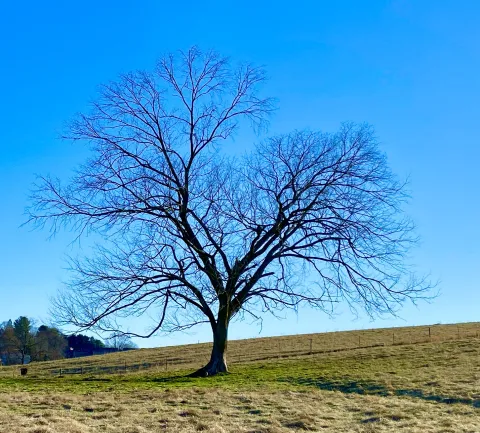Trees in Winter Are Worth a Look

By: Steve Roark
Volunteer, Cumberland Gap National Historical Park
When the forest is laid bare each winter there is a tendency to think of it as a bleak and dreary place. But the basic structural skeleton of each tree can be seen at this time, with every branch, twig, and bud visible, thus revealing how it has grown in the past, and how it has prepared for the future. So put on a coat, go outside and go take a look.
Trees all have a trunk anchored to the ground. It has a skin of bark, which varies widely in appearance if you look closely. Beech is smooth, cedar is shreddy, and many have a series of ridges separated by furrows that form distinct patterns. There’s a lot of color variation as well, and with a good field guide you can identify trees by their bark alone.
Branching off the trunk are major limbs that eventually divide to form branches that in turn divide to form small branches and finally twigs. Standing back and looking at a winter tree silhouette reveals how the tree has grown in the past to maximize lifting its leaves to the sun, which is the basic yet elegant purpose of growing in such a three-dimensional form. Grabbing sunlight to make food is the name of the game. There are two main patterns you will want to notice. One is a single main trunk with limbs and branches radiating off it. The other has the trunk splitting fairly soon into major limbs that spread to form a wide canopy. The first form is conical and sort of pointed, like cedars, pines, and yellow poplar. The second form is more spreading and rounded, like oak, elm, and sycamore. How large a tree canopy becomes depends on several things, but mostly on the amount of sunlight it receives. Open grown trees like in a field can spread in all directions and have large, wide canopies. Trees in a forest have to stretch themselves tall to stay ahead of neighboring trees as they fight for position in the sun. They will have long, limb free trunks that finally form a much smaller canopy.
There’s one other thing to notice about a tree’s branching pattern. Some species have what is called opposite branching, meaning the smaller branches form on the larger branches in opposing pairs. This will be evident throughout the canopy, right down to the buds. Maples, dogwood, buckeye, and ash all have opposite branching. The other pattern is called alternate, where the branches form randomly here and there, and this is found in oak, hickory, and others species.
Besides bark and branching patterns, one final feature to check out is the winter buds, the time capsules of next year’s growth. Inside each one is a miniaturized leaf that in the Spring will unfurl and provide food for life. Some are flower buds that eventually make the seeds that fulfill the great desire of all life forms… to have offspring and continue the species. Buy a small magnifying glass and look at the buds up close. They are amazingly complex and varied, each species having its own pattern of bud scales, shapes, and colors.
Next time you take a winter walk in the woods, and enlarge your world by looking closer at the trees.
- Log in to post comments